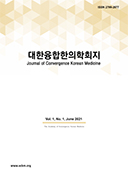호흡기를 통한 약액 전달을 위한 진세노사이드 초미세입자 분무장치 제작
Fabrication of an ultra-fine ginsenoside particle atomizer for drug delivery through respiratory tract
박진수 (한국과학기술연구원 뇌과학연구소)
양웅모 (경희대학교 한의과대학 융합한의과학교실)
Abstract
Objectives: The purpose of this study is to fabricate an ultra-fine ginsenoside particle atomizer that can provide a new treatment method by delivering ginsenoside components that have a therapeutic effect on respiratory diseases directly to the lungs. Methods: We fabricated the AAO vibrating mesh by using the micromachining process. The starting substrate of an AAO wafer has a 350nm pore diameter with 50㎛ thickness. A photomask having several 5㎛ opening holes with a 100㎛ pitch was used to separate each nanopore nozzle. The photoresist structure was optimized to pattern the nozzle area during the lift-off process precisely. The commercial vibrating mesh was removed from OMRON's NE-U100 product, and the fabricated AAO vibrating mesh was installed. A diluted sample of 20mL with 30% red ginseng concentrate was prepared to atomize from the device. Results: As a result of liquid chromatography analysis before spraying the ginsenoside solution, ginsenoside components such as 20S-Rg3, 20R-Rg3, and Rg5 were detected. After spraying through the AAO vibrating mesh, ginsenosides of the same component could be detected. Conclusion: A nutrient solution containing ginsenosides was successfully sprayed through the AAO vibrating mesh with 350 nm selective pores. In particular, during the atomizing experiment of ginsenoside drug solution having excellent efficacy in respiratory diseases, it was confirmed that atomizing through the AAO vibrating mesh while maintaining most of the active ingredients was carried out.
- keywords
- Atomizer, Anodic Aluminum Oxide (AAO), Ginsenoside, Aerosol, Ultra-fine particle
- 다운로드 수
- 조회수
- 0KCI 피인용수
- 0WOS 피인용수


